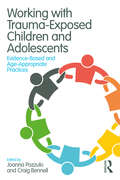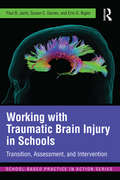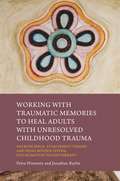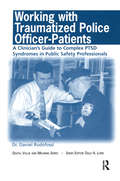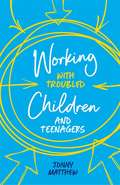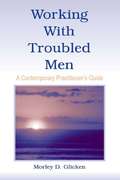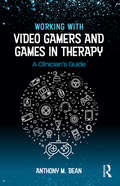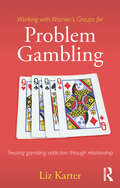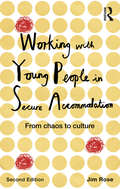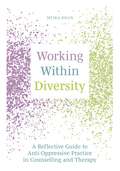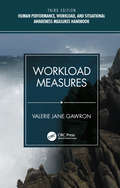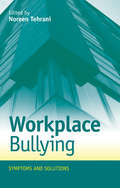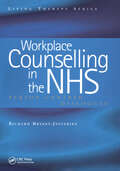- Table View
- List View
Working with Trauma-Exposed Children and Adolescents: Evidence-Based and Age-Appropriate Practices
by Joanna Pozzulo Craig BennellFar too often, children and youth experience trauma, from rare events such as mass shootings, terrorism attacks, and school lockdowns, to very common occurrences such as bullying, exposure to drugs and alcohol, or various mental health issues. They can experience these events both directly and indirectly (from surfing the internet, watching television, or through their friends). Our children spend a large portion of their day at school interacting with other students, teachers, and school personnel, where these topics are raised and discussed. This edited volume addresses how our teachers and school personnel can help students deal with these potentially traumatic events to reach the most positive possible outcomes. This collection brings together leading experts, including academics and professionals working in the field, to provide the most current evidence-based practices on how to help students who may have experienced or witnessed trauma. It presents research and advice on how to respond to traumatic events regarding bullying; drugs and alcohol; sexual abuse; mental health; lesbian, gay, bisexual, transgender, and queer (LGBTQ) safety; stranger danger; childhood disruptive behaviors; school shootings and lockdowns; and terrorism. It also includes a chapter focused on how to implement a school safety program. Schools cannot deal with these issues alone; effective strategies must engage family members and the broader community. Hence, the collection includes a chapter on how schools can partner with families and the communities they reside in to bring about positive change. All this work pays close attention to cultural and religious sensitivity, socio-economic variabilities, diversity issues, and developmental stages.
Working with Trauma-Exposed Children and Adolescents: Evidence-Based and Age-Appropriate Practices
by Joanna Pozzulo Craig BennellFar too often, children and youth experience trauma, from rare events such as mass shootings, terrorism attacks, and school lockdowns, to very common occurrences such as bullying, exposure to drugs and alcohol, or various mental health issues. They can experience these events both directly and indirectly (from surfing the internet, watching television, or through their friends). Our children spend a large portion of their day at school interacting with other students, teachers, and school personnel, where these topics are raised and discussed. This edited volume addresses how our teachers and school personnel can help students deal with these potentially traumatic events to reach the most positive possible outcomes. This collection brings together leading experts, including academics and professionals working in the field, to provide the most current evidence-based practices on how to help students who may have experienced or witnessed trauma. It presents research and advice on how to respond to traumatic events regarding bullying; drugs and alcohol; sexual abuse; mental health; lesbian, gay, bisexual, transgender, and queer (LGBTQ) safety; stranger danger; childhood disruptive behaviors; school shootings and lockdowns; and terrorism. It also includes a chapter focused on how to implement a school safety program. Schools cannot deal with these issues alone; effective strategies must engage family members and the broader community. Hence, the collection includes a chapter on how schools can partner with families and the communities they reside in to bring about positive change. All this work pays close attention to cultural and religious sensitivity, socio-economic variabilities, diversity issues, and developmental stages.
Working with Traumatic Brain Injury in Schools: Transition, Assessment, and Intervention (School-Based Practice in Action)
by Paul B. Jantz Susan C. Davies Erin D. BiglerEvery day, children and adolescents worldwide return to the educational setting having sustained a traumatic brain injury (TBI). The possible negative consequences of TBI range from mild to severe and include neurological, cognitive, emotional, social, and behavioral difficulties. Within the school setting, the negative effects of TBI tend to persist or worsen over time, often resulting in academic and social difficulties that require formal and informal educational assistance and support. School psychologists and other educational professionals are well-positioned to help ensure students with TBI receive this assistance and support. Working with Traumatic Brain Injury in Schools is a comprehensive practitioner-oriented guide to effective school-based services for students who have experienced a TBI. It is primarily written for school-based professionals who have limited or no neurological or neuropsychological training; however, it contains educational information that is useful to professionals with extensive knowledge in neurology and/or neuropsychology. This book is also written for parents and guardians of students with TBI because of their integral role in the transition, school-based assessment, and school-based intervention processes. Chapter topics include: basic brain anatomy and physiology; head injury and severity level classifications; biomechanics of injury; injury recovery and rehabilitation; neurological, cognitive, emotional, behavioral, social, and academic consequences; understanding community-based assessment findings; a framework for school-based assessment (TBI-SNNAP); school-based psychoeducational report writing, and school-based interventions; monitoring pharmacological interventions; and prevention. An accompanying website includes handouts, sample reports, and training templates to assist professionals in recognizing and responding to students with TBI.
Working with Traumatic Brain Injury in Schools: Transition, Assessment, and Intervention (School-Based Practice in Action)
by Paul B. Jantz Susan C. Davies Erin D. BiglerEvery day, children and adolescents worldwide return to the educational setting having sustained a traumatic brain injury (TBI). The possible negative consequences of TBI range from mild to severe and include neurological, cognitive, emotional, social, and behavioral difficulties. Within the school setting, the negative effects of TBI tend to persist or worsen over time, often resulting in academic and social difficulties that require formal and informal educational assistance and support. School psychologists and other educational professionals are well-positioned to help ensure students with TBI receive this assistance and support. Working with Traumatic Brain Injury in Schools is a comprehensive practitioner-oriented guide to effective school-based services for students who have experienced a TBI. It is primarily written for school-based professionals who have limited or no neurological or neuropsychological training; however, it contains educational information that is useful to professionals with extensive knowledge in neurology and/or neuropsychology. This book is also written for parents and guardians of students with TBI because of their integral role in the transition, school-based assessment, and school-based intervention processes. Chapter topics include: basic brain anatomy and physiology; head injury and severity level classifications; biomechanics of injury; injury recovery and rehabilitation; neurological, cognitive, emotional, behavioral, social, and academic consequences; understanding community-based assessment findings; a framework for school-based assessment (TBI-SNNAP); school-based psychoeducational report writing, and school-based interventions; monitoring pharmacological interventions; and prevention. An accompanying website includes handouts, sample reports, and training templates to assist professionals in recognizing and responding to students with TBI.
Working with Traumatic Memories to Heal Adults with Unresolved Childhood Trauma: Neuroscience, Attachment Theory and Pesso Boyden System Psychomotor Psychotherapy
by Jonathan Baylin Petra WinnetteWhat potential does psychotherapy have for mediating the impact of childhood developmental trauma on adult life? Combining knowledge from trauma-focused work, understandings of the developmental brain and the neurodynamics of psychotherapy, the authors explain how good care and poor care in childhood influence adulthood. They provide scientific background to deepen understanding of childhood developmental trauma. They introduce principles of therapeutic change and how and why mind-body and brain-based approaches are so effective in the treatment of developmental trauma. The book focuses in particular on Pesso Boyden System Psychotherapy (PBSP) which uniquely combines and integrates key processes of mind-body work that can facilitate positive change in adult survivors of childhood maltreatment. Through client stories Petra Winnette and Jonathan Baylin describe the clinical application of PBSP and the underlying neuropsychological concepts upon which it is based. Working with Traumatic Memories to Heal Adults with Unresolved Childhood Trauma has applications relevant to psychotherapists, psychologists and psychiatrists working with clients who have experienced trauma.
Working with Traumatic Memories to Heal Adults with Unresolved Childhood Trauma: Neuroscience, Attachment Theory and Pesso Boyden System Psychomotor Psychotherapy (PDF)
by Jonathan Baylin Petra WinnetteWhat potential does psychotherapy have for mediating the impact of childhood developmental trauma on adult life? Combining knowledge from trauma-focused work, understandings of the developmental brain and the neurodynamics of psychotherapy, the authors explain how good care and poor care in childhood influence adulthood. They provide scientific background to deepen understanding of childhood developmental trauma. They introduce principles of therapeutic change and how and why mind-body and brain-based approaches are so effective in the treatment of developmental trauma. The book focuses in particular on Pesso Boyden System Psychotherapy (PBSP) which uniquely combines and integrates key processes of mind-body work that can facilitate positive change in adult survivors of childhood maltreatment. Through client stories Petra Winnette and Jonathan Baylin describe the clinical application of PBSP and the underlying neuropsychological concepts upon which it is based. Working with Traumatic Memories to Heal Adults with Unresolved Childhood Trauma has applications relevant to psychotherapists, psychologists and psychiatrists working with clients who have experienced trauma.
Working with Traumatized Police-Officer Patients: A Clinician's Guide to Complex PTSD Syndromes in Public Safety Professionals (Death, Value and Meaning Series)
by Daniel Rudofossi Dale A. Lund Alan W. BennerAn insider perspective from a 'cop doc on the job,' this book is the first of its kind written in response to a need for a specialized guide for clinicians that operationally defines and responsibly treats what Dan Rudofossi terms Police and Public Safety Complex PTSD. In reading this book, you are led through an understanding of how to work with police officers who experience cumulative loss in trauma. "Doc Dan" initiates you into an original cultural competence of how and why his theory works in practice. You will leave the journey with a practical sense of how the ecological context and ethological motivation are part of the psychological presentation of almost all officers suffering from complex trauma and loss.This guide is crucial reading, original in its breadth and scope of perspective on how to intervene with the traumatized officer. Toward that end, Rudofossi presents his Eco-Ethological Existential Analysis of Police and Public Safety Complex Post Traumatic Stress Disorder. Emotive, affective, cognitive, behavioral, and existential ranges of expression of trauma are vast, diverse, and often intense in police officers. This book delivers applied theory with clinical examples, including practical interventions for the clinician and handouts for the officer-patient. The clinician will be assisted in encountering officers' existential suffering from the edge of despair to the precipice of meaning. The guide is at once stimulating, exciting, and very serious in its potential for clinical interventions.
Working with Traumatized Police-Officer Patients: A Clinician's Guide to Complex PTSD Syndromes in Public Safety Professionals (Death, Value and Meaning Series)
by Daniel Rudofossi Dale A. Lund Alan W. BennerAn insider perspective from a 'cop doc on the job,' this book is the first of its kind written in response to a need for a specialized guide for clinicians that operationally defines and responsibly treats what Dan Rudofossi terms Police and Public Safety Complex PTSD. In reading this book, you are led through an understanding of how to work with police officers who experience cumulative loss in trauma. "Doc Dan" initiates you into an original cultural competence of how and why his theory works in practice. You will leave the journey with a practical sense of how the ecological context and ethological motivation are part of the psychological presentation of almost all officers suffering from complex trauma and loss.This guide is crucial reading, original in its breadth and scope of perspective on how to intervene with the traumatized officer. Toward that end, Rudofossi presents his Eco-Ethological Existential Analysis of Police and Public Safety Complex Post Traumatic Stress Disorder. Emotive, affective, cognitive, behavioral, and existential ranges of expression of trauma are vast, diverse, and often intense in police officers. This book delivers applied theory with clinical examples, including practical interventions for the clinician and handouts for the officer-patient. The clinician will be assisted in encountering officers' existential suffering from the edge of despair to the precipice of meaning. The guide is at once stimulating, exciting, and very serious in its potential for clinical interventions.
Working with Troubled Children and Teenagers
by Jonny MatthewWorking with Troubled Children and Teenagers is an easy to understand guide packed with wisdom for anyone working with or caring for troubled children and teens. Author Jonny Matthew has decades of experience of working with young people, and offers simple but hard-won advice about how to earn the trust and respect of even the most challenging young people. It all starts with you, the adult, adopting a position of respect and patience. It's only then that children and young people will start to respond. From this starting point, Jonny provides a wealth of practical advice across a wide range of challenging topics - from the use of touch and understanding boundaries through to repairing relationships when things break down. Jonny uses case examples and stories throughout to bring his advice to life. This inspiring book is essential reading for any adult invested in improving the lives of troubled children, including youth workers, social workers, foster carers and child counsellors.
Working With Troubled Men: A Contemporary Practitioner's Guide
by Morley D. GlickenThis book offers a concise, readable, research-grounded synthesis of the special concerns mental health and other helping professionals need to address when working with men today, and explains a wealth of effective gender-specific approaches to assessment and intervention that result in more successful outcomes for male clients.Many more women than men seek counseling and therapy, and to some extent standard services have evolved in response to female styles of communicating and problem-solving. Practitioners frequently feel frustrated and baffled by their male clients because they seem unresponsive to treatment approaches that work so well for women. But many men benefit from therapy when practitioners understand male socialization and the ways men communicate and problem-solve.Too many men today are doing badly and are in real need of help. Almost half of America's male children grow up in single parent homes headed by mothers, where they seldom have male mentors or role models. Fewer men than women attend or graduate from college, and increasing levels of binge drinking and date rape on campuses paint a discouraging picture of men on campus. Male violence continues to be a serious problem in many American communities, with male youth violence continuing at epidemic levels. Men die younger than women overall and in much higher proportions from suicide, homicide, and cirrhosis of the liver.
Working With Troubled Men: A Contemporary Practitioner's Guide
by Morley D. GlickenThis book offers a concise, readable, research-grounded synthesis of the special concerns mental health and other helping professionals need to address when working with men today, and explains a wealth of effective gender-specific approaches to assessment and intervention that result in more successful outcomes for male clients.Many more women than men seek counseling and therapy, and to some extent standard services have evolved in response to female styles of communicating and problem-solving. Practitioners frequently feel frustrated and baffled by their male clients because they seem unresponsive to treatment approaches that work so well for women. But many men benefit from therapy when practitioners understand male socialization and the ways men communicate and problem-solve.Too many men today are doing badly and are in real need of help. Almost half of America's male children grow up in single parent homes headed by mothers, where they seldom have male mentors or role models. Fewer men than women attend or graduate from college, and increasing levels of binge drinking and date rape on campuses paint a discouraging picture of men on campus. Male violence continues to be a serious problem in many American communities, with male youth violence continuing at epidemic levels. Men die younger than women overall and in much higher proportions from suicide, homicide, and cirrhosis of the liver.
Working with Video Gamers and Games in Therapy: A Clinician's Guide
by Anthony M. BeanWorking with Video Gamers and Games in Therapy moves beyond stereotypes about video game addiction and violence to consider the role that games play in psychological experiences and mental health. Chapters examine the factors that compel individual gamers to select and identify with particular games and characters, as well as the different play styles, genres, and archetypes common in video games. For clinicians looking to understand their clients’ relationships with video games or to use games as a therapeutic resource in their own practice, this is a thoughtful, comprehensive, and timely resource.
Working with Video Gamers and Games in Therapy: A Clinician's Guide
by Anthony M. BeanWorking with Video Gamers and Games in Therapy moves beyond stereotypes about video game addiction and violence to consider the role that games play in psychological experiences and mental health. Chapters examine the factors that compel individual gamers to select and identify with particular games and characters, as well as the different play styles, genres, and archetypes common in video games. For clinicians looking to understand their clients’ relationships with video games or to use games as a therapeutic resource in their own practice, this is a thoughtful, comprehensive, and timely resource.
Working with Women's Groups for Problem Gambling: Treating gambling addiction through relationship
by Liz KarterWhy do so many women with gambling addiction relapse? Lifelong recovery requires much more than to just stop gambling. Women’s groups provide long-term benefits and support and have proven to be highly successful in promoting recovery from gambling addiction. By following the story of a real women’s group for problem gambling over the course of a year, Liz Karter explains how, for women, both the cause of and the cure for gambling addiction lies in relationship. Karter shows clearly how learning to face and cope with real life situations and relationships is essential to maintain recovery. She shares the themes which run through each women’s group, such as fear of trusting others, and the guilt, shame and risk associated with being truly seen and heard. Women’s Groups for Problem Gambling shows that with a combination of specialist intervention, women’s group support, courage and compassion, women can learn to stop running from their addiction and instead find joy and support in building relationships and communities. This highly accessible book provides a unique opportunity to gain a very personal insight into the group process, both for therapists and clinicians and for women wishing to better understand their addiction.
Working with Women's Groups for Problem Gambling: Treating gambling addiction through relationship
by Liz KarterWhy do so many women with gambling addiction relapse? Lifelong recovery requires much more than to just stop gambling. Women’s groups provide long-term benefits and support and have proven to be highly successful in promoting recovery from gambling addiction. By following the story of a real women’s group for problem gambling over the course of a year, Liz Karter explains how, for women, both the cause of and the cure for gambling addiction lies in relationship. Karter shows clearly how learning to face and cope with real life situations and relationships is essential to maintain recovery. She shares the themes which run through each women’s group, such as fear of trusting others, and the guilt, shame and risk associated with being truly seen and heard. Women’s Groups for Problem Gambling shows that with a combination of specialist intervention, women’s group support, courage and compassion, women can learn to stop running from their addiction and instead find joy and support in building relationships and communities. This highly accessible book provides a unique opportunity to gain a very personal insight into the group process, both for therapists and clinicians and for women wishing to better understand their addiction.
Working with Young People in Secure Accommodation: From chaos to culture
by Jim RoseThe detention of children and young people as a response to delinquent and antisocial behaviour remains a topical and controversial issue. In this new edition of Working with Young People in Secure Accommodation, Jim Rose provides an historical perspective on the topic of young people in custody and discusses the changes that have taken place in youth justice and the secure estate over recent years. Rose introduces new material and has updated the original content in order to reflect changes in policy and practice. New areas covered include a consideration of the issues arising for children and families who are detained while issues of immigration and removal are being determined and the detention of children in police custody. Using a framework of ideas and theories to support staff thinking, the central chapters explore in detail the dynamics that emerge when the daily work of staff requires them to engage with vulnerable young people in the intense conditions of a locked environment. The relationships between staff and young people are shown as critical for the achievement of positive outcomes. Taking a unique look at the issue of detention and its impact on young people, this highly topical book will be invaluable reading for practitioners, academics, policy makers and senior managers as well as students of social work, youth justice and education.
Working with Young People in Secure Accommodation: From chaos to culture
by Jim RoseThe detention of children and young people as a response to delinquent and antisocial behaviour remains a topical and controversial issue. In this new edition of Working with Young People in Secure Accommodation, Jim Rose provides an historical perspective on the topic of young people in custody and discusses the changes that have taken place in youth justice and the secure estate over recent years. Rose introduces new material and has updated the original content in order to reflect changes in policy and practice. New areas covered include a consideration of the issues arising for children and families who are detained while issues of immigration and removal are being determined and the detention of children in police custody. Using a framework of ideas and theories to support staff thinking, the central chapters explore in detail the dynamics that emerge when the daily work of staff requires them to engage with vulnerable young people in the intense conditions of a locked environment. The relationships between staff and young people are shown as critical for the achievement of positive outcomes. Taking a unique look at the issue of detention and its impact on young people, this highly topical book will be invaluable reading for practitioners, academics, policy makers and senior managers as well as students of social work, youth justice and education.
Working Within Diversity: A Reflective Guide to Anti-Oppressive Practice in Counselling and Therapy
by Myira KhanIn this reflective guide, Myira Khan tackles what it means to work within diversity as a therapist - to actively reflect on your own identity and experiences and how they affect the therapeutic relationships between you and your clients. Presenting a model of anti-oppressive practice, the book examines topics such as power and privilege, cultural humility and how professionals can work to remove barriers to counselling and therapy. It focuses specifically on race, ethnicity and faith, while also considering the implications of intersectional identities. The workbook elements of this book encourage self-reflection and the implementation of new ideas within the therapeutic process. There is an emphasis on practical application throughout the book and it will inspire readers to consider what 'working within diversity' and working cross-culturally really looks like in the therapy room itself.
Workload Measures
by Valerie Jane GawronThis book was developed to help researchers and practitioners select measures to be used in the evaluation of human/machine systems. The book includes definitions of human workload and a review of measures. Each measure is described, along with its strengths and limitations, data requirements, threshold values, and sources of further information. To make this reference easier to use, extensive author and subject indices are provided. Features Offers readily accessible information on workload measures Presents general description of the measure Covers data collection, reduction, and analysis requirements Details the strengths and limitations or restrictions of each measure, including proprietary rights or restrictions Provides validity and reliability data as available
Workload Measures
by Valerie Jane GawronThis book was developed to help researchers and practitioners select measures to be used in the evaluation of human/machine systems. The book includes definitions of human workload and a review of measures. Each measure is described, along with its strengths and limitations, data requirements, threshold values, and sources of further information. To make this reference easier to use, extensive author and subject indices are provided. Features Offers readily accessible information on workload measures Presents general description of the measure Covers data collection, reduction, and analysis requirements Details the strengths and limitations or restrictions of each measure, including proprietary rights or restrictions Provides validity and reliability data as available
Workout mit Baby: Was gut tut und fit hält
by Josef Kessler Constanze Bast-Kessler Jana KriegerFit nach der Geburt und ein zufriedenes Baby - das wünschen sich Mütter, Väter und Großeltern. Keine Zeit für das Fitnessstudio, keine Geräte zuhause? Das Kind will geknuddelt, bewegt oder beruhigt werden? Lassen Sie sich ein auf Übungen, mit denen Sie selbst mobil und stark bleiben und die Sie zusammen mit dem Baby ganz einfach durchführen können.Das Buch bietet mithilfe von Illustrationen Anleitungen für kurze Trainingseinheiten, die Sie spielerisch in den Alltag einstreuen können. Inklusive Aufwärmübungen, Muskeltraining und Dehnungen. Nebenbei erklären der Neuropsychologe und die Psychologin, wie sich das Kind nach der Geburt geistig und körperlich entwickelt und wie Sie fit bleiben, gemeinsam mit dem Baby viel Spaß haben und gleichzeitig dessen Motorik und Sinne ansprechen.
Workplace Bullying: Symptoms and Solutions
by Noreen TehraniIs bullying really that bad? Why do some people just watch it happening? How do you know if it is bullying or strong management? What kind of leaders are able to create positive working environments? The effects of bullying on organisations and individuals can be devastating and can adversely affect both the workers themselves and the productivity of the organisation that they work for. This book explores the impact of bullying from the perspective of both the employee and the organisation in which they work. In addition to describing the negative outcome of bullying, Workplace Bullying also looks at ways to promote resilience and the opportunity for growth and learning to take place. Divided into four sections, this book covers: the impact and symptoms of workplace bullying individual interventions organisational interventions underlying causes and future considerations. Workplace Bullying is essential reading for anyone with responsibility to help and support workers involved in bullying as a victim, supporter, or investigator. It offers organisations a chance to create an environment that will not only build a more resilient workforce, providing appropriate and effective interventions, but also provides solutions that will lead to the possibility of individual and organisational growth and development.
Workplace Bullying: Symptoms and Solutions
by Noreen TehraniIs bullying really that bad? Why do some people just watch it happening? How do you know if it is bullying or strong management? What kind of leaders are able to create positive working environments? The effects of bullying on organisations and individuals can be devastating and can adversely affect both the workers themselves and the productivity of the organisation that they work for. This book explores the impact of bullying from the perspective of both the employee and the organisation in which they work. In addition to describing the negative outcome of bullying, Workplace Bullying also looks at ways to promote resilience and the opportunity for growth and learning to take place. Divided into four sections, this book covers: the impact and symptoms of workplace bullying individual interventions organisational interventions underlying causes and future considerations. Workplace Bullying is essential reading for anyone with responsibility to help and support workers involved in bullying as a victim, supporter, or investigator. It offers organisations a chance to create an environment that will not only build a more resilient workforce, providing appropriate and effective interventions, but also provides solutions that will lead to the possibility of individual and organisational growth and development.
Workplace Counselling in the NHS: Person-Centred Dialogues (Living Therapies Series)
by Richard Bryant-JefferiesThis book has been written specifically to meet the needs of counsellors and trainers working with the National Health Service. It will also provide useful insights for doctors, nurses, and managers within the healthcare sector. The book covers topics such as, difference and diversity, colour, language barriers, oppressed nurses, stressed managers, changes in the NHS, exhaustion and late cancellations. Adopting the unique approach of the Living Therapy series, this book uses fictitious dialogues to enable the reader to directly experience the therapeutic process, providing real insight into the experience of workplace counselling in the NHS and also in other work settings.
Workplace Counselling in the NHS: Person-Centred Dialogues (Living Therapies Series)
by Richard Bryant-JefferiesThis book has been written specifically to meet the needs of counsellors and trainers working with the National Health Service. It will also provide useful insights for doctors, nurses, and managers within the healthcare sector. The book covers topics such as, difference and diversity, colour, language barriers, oppressed nurses, stressed managers, changes in the NHS, exhaustion and late cancellations. Adopting the unique approach of the Living Therapy series, this book uses fictitious dialogues to enable the reader to directly experience the therapeutic process, providing real insight into the experience of workplace counselling in the NHS and also in other work settings.
